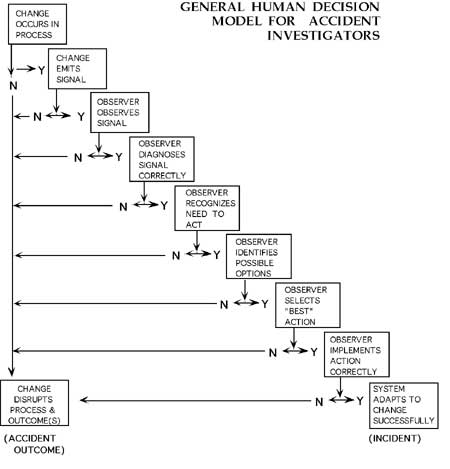HUMAN DECISION MODEL
This model is designed to help investigators formulate questions when they inquire
into what people did, and why they did it. The Model deals with interactions between
people and other people or objects during systems operations. It helps investigators
discover sensory, communication, diagnostic, attitudinal, decision making, training,
design, procedural, supervisory and many other problems related to "human factors" in a
way that defines specific problems, needs and actions, rather than ambiguous or abstract
categories of "factors" or root causes or unsafe actions or unsafe conditions.

To apply this Model during investigations or interviews, the following is offered:
| First, identify people who appear to have acted and affected the
outcome of the incident process. Then begin to look for a change in the activity
that would have created a need for action by that person to keep the activity
progressing toward its intended outcome. |
 |
| When you identify that change, determine if it emitted
some kind on signal that the person could have noticed. If it didn't you explore why it didn't and what effect that had on the outcome. |
 |
| If it did emit a signal, explore whether the person saw, heard, felt or otherwise "observed" the signal. If not, explore why not, and what effect that had on the outcome. |
 |
| If the person observed the signal, was the signal diagnosed correctly, in the sense that the person was able predict the consequence of the change from the signal and their knowledge of the system and its operation. If not, explore why not, and its effects. |
 |
| If the predicted consequences of the change were correctly
identified, did the person recognize a need to do something (intervene) to counter
those consequences? If not, explore why not, and its effects. |
 |
| If so, did the person identify the choices for action that were
available for successful intervention? Was this a new situation were the action had
to be invented, or was this something that prior training anticipated and provided
the responses to implement? In other words, was the person confronted by an adaptive
or habituated response? (Here, you start to get into the person's decision making
process, and potential personal judgment issues, so explore this area with empathy
toward the witness, particularly for adaptive responses.) Other paths might lead to
training, hazard analysis, prior deviations, policy, etc. |
 |
| If any response actions were identified, did the person choose the
"best" or an effective response to implement? If a successful response was not
chosen, explore why it wasn't. Was it an interpretation or diagnostic problem,
time constraint, training problem, risk decision making skill problem, distraction,
etc.? |
 |
| If a successful response was chosen, did the person successfully
implement the desired action? If not, explore why not. Was it a skill problem,
timing problem, support problem, tools problem, etc.? |
 |
| If a suitable response was implemented, the system adapted to the
change without an accidental loss or harm. If the response did not achieve a
no-accident outcome, explore why it didn't. Often this leads you to discovery of
invalid system design assumptions or other design problems. Recognize what kept
incident from becoming major loss. |
 |
After working with this model, you will be in a much better position to describe and
explain what happened when a so-called "human error" or "failure" is alleged. You will
also be in a better position to identify concrete actions to improve future performance
of that system.
|
|
